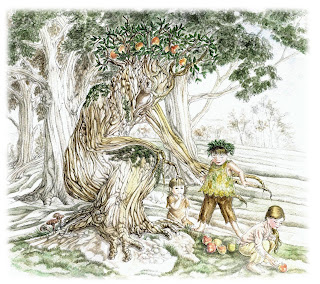Witches Ladders have been in use for hundreds of years though not many examples
remain from that time.
One such ladder can be viewed in the Pitt Rivers Museum in Oxford.
This is a long length of knotted cord with different coloured feathers
woven through out its length, its use would have been to cast spells and
more often than not used for a death spell.
But they can be used for a more benign purpose;
the following spell using a Witches Ladder is for protection, abundance
and happiness.
Much nicer!
You will need 3 lengths of cord or string or even thread, ( blue for protection)
each approx three feet in length.
Beads, feathers or some small charms or amulets.
Taking the three lengths tie them together at one end.
As you begin to plait them together concentrate your intent and will onto
the forming braid beneath your fingers.
At any place that you feel the need make a knot and work a bead, feather or charm
into the plait, at all times keeping the intent of the spell in your mind.
As you create each knot chant the following:
“By knot of One, the Spell’s begun,
by knot of Two, the Magic comes true,
by knot of Three, so it shall be,
by knot of Four, this Power is Stored,
by knot of Five, my Will shall drive,
by knot of Six, the spell I fix,
by knot of Seven, the future I leaven,
by knot of Eight, my will be fate,
by knot of Nine, what is done is mine.”
Then you can hang the Witches Ladder where needed.
Witches Ladders were often bought by sailors for protection whilst at sea.
The sailors also believed that the witches bound up the wind inside the knots and
when needed if a knot was released the wind could be summoned to aid the ship in its journey.
In Italy they have a similar tradition but here it is called a“witches garland”,
made of cord, and would have contained black hen feathers.
The malediction was uttered as each knot was tied in and the item was placed
under the victim's bed. The cord would have had some of the victims hair braided
into it along with feathers plucked from a live black hen.
The curse could be lifted by finding the wreath and the hen and throwing them
into running water.
The victim is then taken into the church while they are bathed in
Holy water while reciting a spell.
This is a good Witches Ladder for Healing:
Take an eight inch length of cord or string, divide it into seven equal parts.
And mark the cord so at each mark you tie a knot and repeat the following six times.
“Disease, no one asks you to stay,
It’s time for you to fade,
With these knots I ask your leave
With these words I weave.”
Once finished place the knotted cord along with some salt into a container
and seal the top with the above spell written on a piece of paper.
Then bury the container, as close as possible beneath an Ash tree which is
associated with healing.
Be careful not to damage the tree whilst doing so!
















































